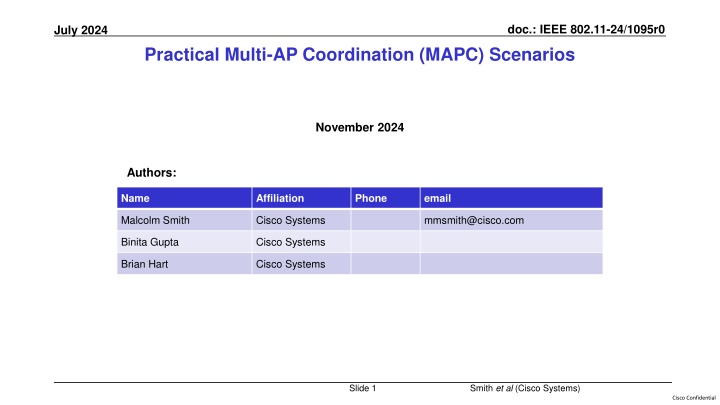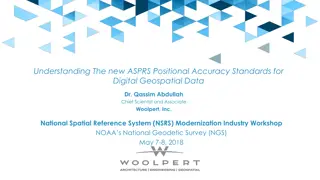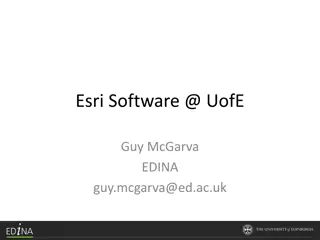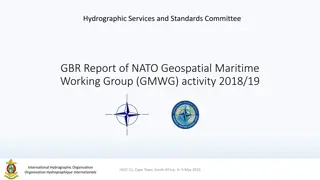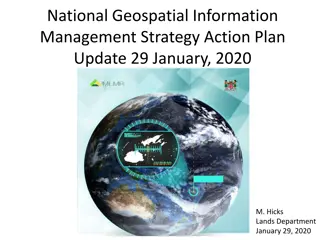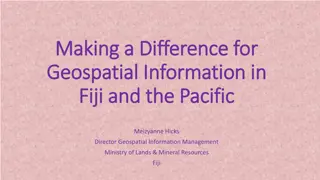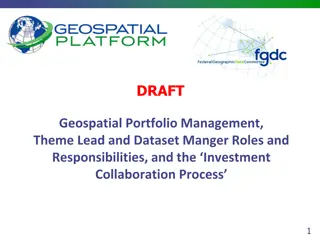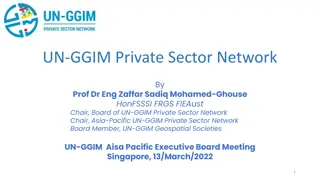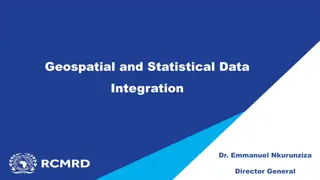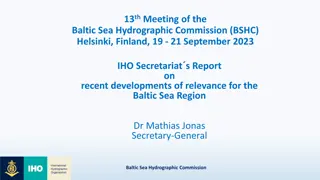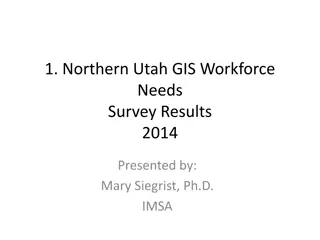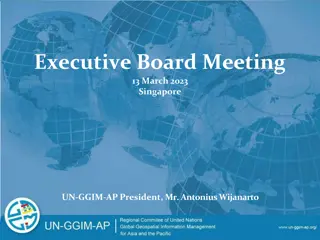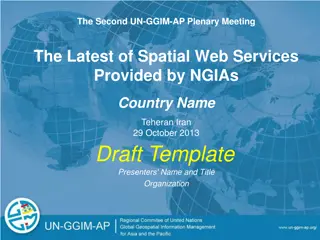Revolutionizing Geospatial Web Services for Enhanced User Experience
Revolutionize geospatial web services for enhanced user experience by redesigning content around a common theme, promoting open data standards, leveraging geospatial tools, and making pages interactive. The current progress includes a prototype for an integrated toolkit with support for coordinate transformation and web services. The next steps involve standardizing attribute naming conventions and integrating additional toolkit components. Develop a standard API for interpolation to further enhance the user experience.
Download Presentation

Please find below an Image/Link to download the presentation.
The content on the website is provided AS IS for your information and personal use only. It may not be sold, licensed, or shared on other websites without obtaining consent from the author.If you encounter any issues during the download, it is possible that the publisher has removed the file from their server.
You are allowed to download the files provided on this website for personal or commercial use, subject to the condition that they are used lawfully. All files are the property of their respective owners.
The content on the website is provided AS IS for your information and personal use only. It may not be sold, licensed, or shared on other websites without obtaining consent from the author.
E N D
Presentation Transcript
doc.: IEEE 802.11-24/1095r0 July 2024 Practical Multi-AP Coordination (MAPC) Scenarios November 2024 Authors: Name Affiliation Phone email Malcolm Smith Cisco Systems mmsmith@cisco.com Binita Gupta Cisco Systems Brian Hart Cisco Systems Slide 1 Smith et al (Cisco Systems) Cisco Confidential
doc.: IEEE 802.11-24/1095r0 July 2024 Problem Statement Multi-service network that simultaneously supports: Low-latency channel access for multi-media, IIOT, XR, etc (~10ms) Ultra-reliable/ultra-low latency channel access for XR & IIOT/Wireless Time-Sensitive Networking (~1ms) Devices subject to irregular in-device coexistence (IDC) challenges Devices with P2P traffic Managed contention/congestion from OBSS With optimizations within the same MANAGED administrative domain (e.g. TUA-O, R-TWT, MLO) With limited control over other UNAMNAGED administrative domains (e.g. QoS) With: High system efficiency Implementation simplicity Acceptable fairness with legacy generations Slide 2 Smith et al (Cisco Systems) Cisco Confidential
doc.: IEEE 802.11-24/1095r0 July 2024 Key Traffic profiles Wireless TSN (WTSN) e.g. IIOT, XR STA traffic synchronized to WLAN via 802.11 or 802.1 means e.g. 802.1Qbv/AS Rigid SCS QC parameters (SST, SI, etc) Target: 1ms 99.9% (at least) Interactive real-time e.g. XR, UHD video conferencing STA traffic can be synchronized to WLAN via 802.11 means e.g. SCS QC, R-TWT Flexible SCS QC parameters (SST, SI, etc) Target: 1-10ms 99.9% (at least) Collaboration/video-streaming STA traffic periodic but unsynchronized to WLAN Target 10-50ms 99.9% (at least) Non-real-time (background) aperiodic and unsynchronized Slide 3 Smith et al (Cisco Systems) Cisco Confidential
doc.: IEEE 802.11-24/1095r0 July 2024 QoS methods to manage delay congestion (My and OBSS) QoS Apply VI/VO WMM/EDCA parameters to specific flows Available in Managed, SP and Enterprise WLANs Triggered Uplink Access Optimization (TUA-O) Combined with SCS QoS Characteristics (QC) period/SI, delay bound, etc. Expected availability in managed, SP and Enterprise WLANs STA requests via SCS QC and AP aligns traffic with MU trigger with e.g. TWT, R-TWT. SCS QC MLO eMLSR expected to be commonly available in most WLANs Delay optimized mode assumed (i.e. first non-CS link ) Restricted TWT (R-TWT) Mapped to 802.1Qbv gate (time-slot reservation) for Wireless TSN (WTSN) applications Expected to be supported by a limited device set but not universally honored (e.g. legacy) MAPC (C-R-TWT/C-SP/C-TDMA/etc) Under consideration by 802.11bn Details provided as needed Slide 4 Smith et al (Cisco Systems) Cisco Confidential
doc.: IEEE 802.11-24/1095r0 July 2024 BSS Coordination model Managed WLAN QOS (WMM) [assumed default] Wi-Fi 7 (TUA-O/SCS-QC, R-TWT) SCS-QC driven scheduled MAPC service periods (SP) e.g. C-R-TWT, C-SP Priority and/or SCS-driven on-demand (in TXOP) MAPC coordination e.g. C-TDMA Managed to P2P/Unmanaged WLAN Uncoordinated (e.g. WMM QOS) [assumed default] Sharing of priority and SP needs (e.g., SCS-based) Negotiation of SPs Slide 5 Smith et al (Cisco Systems) Cisco Confidential
doc.: IEEE 802.11-24/1095r0 July 2024 Practical QoS analysis objectives Baseline performance with pre-11bn methods on existing 5GHz/40MHz WLAN Most interference expected to be non-QoS or otherwise uncoordinated Predict incremental gains with emerging 6GHz WLAN 80MHz BW expected min. in dense environments (Enterprise, MDU, etc.) Determine scenarios where MAPC provides key QoS benefits Slide 6 Smith et al (Cisco Systems) Cisco Confidential
doc.: IEEE 802.11-24/1095r0 July 2024 Analysis approach/parameters Simulation-based with empirical validation (e,g. Wi-Fi7 TUA-O, Wireless TSN/R-TWT, etc) My BSS and OBSS co-channel (CCI) modeled as best-effort (AC-BE) offered-load (Poisson) to achieve a target Channel Utilization (CU) with heavy (60KB) payload Real-time (RT) offered-load from either uplink Video (VI) [35ms period, 10KB/frame, 2.2Mb/s] with 35ms (default) MU-EDCA TO for TUA-O XR pose (VI/VO) [10ms period, 100B/frame, 80Kb/s] with 10ms MU-EDCA TO for TUA-O Enterprise density assumed 25 BE and 5 BE STA per AP Either one AP (non-MAPC) or (for MAPC) 4 identical co-channel APs (i.e. 25x4+5x4=120 STA) Average MCS 7 (81Mb/s @ 20MHz w/ 1 SS) Only uplink channel ACCESS delay estimated (queueing delay ignored for now) Slide 7 Smith et al (Cisco Systems) Cisco Confidential
doc.: IEEE 802.11-24/1095r0 July 2024 Baseline: Wi-Fi 7 (Typical average peak load) Latency vs. mode 25 1 BSS Video 40MHz 20 Avg. 50% target CU Only WTSN needs a specific QoS method (R-TWT) Latency (ms) 15 10 5 0 No QOS QOS (WMM) MLO (+WMM) TUA (+WMM) R-TWT (+WMM) 90%-ile 99%-ile 99.9%-ile *WTSN Qbv Slide 8 Smith et al (Cisco Systems) Cisco Confidential
doc.: IEEE 802.11-24/1095r0 July 2024 Baseline: Wi-Fi 7 (High load) Latency vs. mode 300 250 1 BSS Video 40MHz 200 Avg. 90% CU Latency (ms) 150 TUA-O needed to meet interactive-real-time/XR 100 R-TWT needed for WTSN 50 0 No QOS QOS (WMM) MLO (+WMM) TUA (+WMM) R-TWT (+WMM)* 90%-ile 99%-ile 99.9%-ile * WTSN Qbv Slide 9 Smith et al (Cisco Systems) Cisco Confidential
doc.: IEEE 802.11-24/1095r0 July 2024 Baseline: Wi-Fi 7 in 6GHz Delay vs. BW 30 1 BSS Video 25 TUA-O 20 Avg. 90% CU Latency (ms) 40->80MHz close to meeting interactive-real-time /XR reqs. 15 10 WTSN reqs. not met 5 0 40MHz 80MHz 160MHz 90%-ile 99%-ile 99.9%-ile Slide 10 Smith et al (Cisco Systems) Cisco Confidential
doc.: IEEE 802.11-24/1095r0 July 2024 Practical MAPC formulation Migration from 5GHz (40MHz) to 6Ghz (80/160MHz) will likely support low-latency (10ms) for a single BSS (no CCI) even at high CU (90%) Ultra-low-latency (1ms) can be met via R-TWT if universally adopted Multi-AP (CCI) will degrade latency further, so we expect TUA or R-TWT to be needed to meet ultra or low latency requirements. For our 4 co-channel AP scenario, each AP uses QoS/WMM or TUA-O WTSN worst-case whereby TUA-O operation is aligned across all APs (e.g. SCS QC have COMPETING Start-Time) NOTE TUA-O is a proxy for R-TWT under unmanaged BSS CCI Slide 11 Smith et al (Cisco Systems) Cisco Confidential
doc.: IEEE 802.11-24/1095r0 July 2024 MAPC: TUA-O vs. QOS (WMM) 99.9% Delay vs. BW 90000 80000 4 BSS Video 70000 Avg. 90% CU 60000 Latency (ms) TUA-O can perform worse than QOS/WMM 50000 40000 (continued on next slide) 30000 20000 10000 0 40MHz 80MHz 160MHz QOS (WMM) TUA-O Slide 12 Smith et al (Cisco Systems) Cisco Confidential
doc.: IEEE 802.11-24/1095r0 July 2024 MAPC: TUA-O MU-EDCA TO side-effect 4 BSS Video Avg. 90% CU @ 80MHz TUA-O w/ MU-EDCA TO = 35ms MU-EDCA TO needs to be lowered to avoid bi-modal PDF @ TO=35ms TO=10ms would shift the EDCA escape point into the TUA-O long tail Slide 13 Smith et al (Cisco Systems) Cisco Confidential
doc.: IEEE 802.11-24/1095r0 July 2024 MAPC: TUA-O MU-EDCA TO optimized 4 BSS Video Avg. 90% CU @ 80MHz TUA-O w/ MU-EDCA TO = 10ms Huge improvement over EDCA (76 vs. 38ms 99.9%) Now can MAPC do better ? Slide 14 Smith et al (Cisco Systems) Cisco Confidential
doc.: IEEE 802.11-24/1095r0 July 2024 MAPC Modeling (C-TUA) As before, TUA-O aligns traffic to trigger at each BSS i.e. 5 VI STA SPs (TID, durations) and a target start time (TST) exchanged amongst APs All APs contend at TST, and leader opens the TXOP via TUA to its own VI STA Leader AP waits SIFS then then uses C-TDMA sequentially with each follower AP (i.e. allocate target duration, wait duration, expect TXOP return) Each follower AP then uses TUA to its own VI STA (within the shared TXOP) As per TUA, MU-EDCA TO allows follower AP to contend separately from leader Since neither BSS-wide not ESS-wide R-TWT is assumed, notionally this is Coordinated TUA or C-TUA Slide 15 Smith et al (Cisco Systems) Cisco Confidential
doc.: IEEE 802.11-24/1095r0 July 2024 MAPC C-TUA 4 BSS Video Avg. 90% CU @ 80MHz C-TUA w/ MU-EDCA TO = 10ms Huge Improvement over TUA-O (38 vs. 23ms 99.9%) Loss is also dramatically improved (50%->~1% [not shown]) Slide 16 Smith et al (Cisco Systems) Cisco Confidential
doc.: IEEE 802.11-24/1095r0 July 2024 Interim results and next steps MAPC (C-TUA) evaluation with AC-VI (Video) indicated improvement but not necessarily preservation of a WTSN (1ms) SLA Gains diminish when fewer APs server per TXOP (not shown for brevity) For completeness, we evaluate with AC-VO (XR Pose i.e., 10ms period, 100B/frame, 80Kb/s) and determine if a similar conclusion is warranted. Applying lessons learned, we optimize the MU-EDCA TO to 5ms (1/2 the period) based on initial (unoptimized) PDF Slide 17 Smith et al (Cisco Systems) Cisco Confidential
doc.: IEEE 802.11-24/1095r0 July 2024 MAPC C-TUA: XR Pose Delay vs. Mode 45 40 4 BSS XR Pose 35 TUA-O/C-TUA-O 30 Avg. 90% CU Latency (ms) 25 XR/IRT requirements met but not WTSN (1ms) without further optimization (e.g. combined use of TUA*) 20 15 10 5 0 QOS TUA C-TUA 90%-ile 99%-ile 99.9%-ile Slide 18 Smith et al (Cisco Systems) Cisco Confidential
doc.: IEEE 802.11-24/1095r0 July 2024 Interim results Choosing AC-VO (for XR Pose) reduces the baseline latency (over AC-VI) both TUA-O and C-TUA-O change the outcome significantly Analysis reveals that the baseline case (4 APs x 30 STA per AP) is subject to: a high collision probability (~90%) generally irrespective of offered load (i.e. 50% and 90% achieved similar results) due to high # of CSMA contenders. initial traffic synchronization (i.e., all STA and/or AP collide by WTSN schedule) also creates additional collisions. C-TUA form of coordination can be a low-cost universal method to achieve lower latency in a latency-sensitive (IRT or WTSN) high-density (HD) multi-AP environment with managed and unmanaged BSS Slide 19 Smith et al (Cisco Systems) Cisco Confidential
doc.: IEEE 802.11-24/1095r0 July 2024 Next-steps (C-SP) To improve upon TUA-O/C-TUA-O for WTSN (hard-start-time) we examine the affect of defined service-periods (SP) without a start-time-protection-rule (STPR) for the BSS itself (i.e. no R-TWT) In C-SP, each AP is assigned a non-overlapping slot within the shared TXOP (skewed slightly from it s target start-time) but doesn t require C-TDMA (TXS) Unlike C-TUA-O, the AP is expected to take the time-slot and NOT contend outside it. Thus, there is a probability the AP will not be served IF the TXOP cannot be obtained at that time Slide 20 Smith et al (Cisco Systems) Cisco Confidential
doc.: IEEE 802.11-24/1095r0 July 2024 MAPC C-SP: XR Pose Delay vs. BW 20 18 4 BSS XR Pose 16 TUA-O/C-SP 14 Avg. 90% CU 12 Latency (ms) C-SP has a marked reduction in latency (but suffers a non-zero loss of ~1% [not shown]) 10 8 6 4 2 0 TUA C-TUA C-SP 90%-ile 99%-ile 99.9%-ile Slide 21 Smith et al (Cisco Systems) Cisco Confidential
doc.: IEEE 802.11-24/1095r0 July 2024 Summary High-Density (HD) Enterprise WLANs suffer from high client density contributing to high co-channel collision rates from both managed BSS and unmanaged BSS Simple MAPC scheduling forms (C-TUA, C-SP) may be used to effectively bound latency in multi-AP environments even with unmanaged BSSs Multi-follower C-TDMA forms offer acceptable latency bounds for interactive-real- time/XR traffic types (1-10ms) Slide 22 Smith et al (Cisco Systems) Cisco Confidential
doc.: IEEE 802.11-24/1095r0 July 2024 References [1] XXXX Slide 23 Smith et al (Cisco Systems) Cisco Confidential
doc.: IEEE 802.11-24/1095r0 July 2024 Straw poll XXXX Y / N / A Slide 24 Smith et al (Cisco Systems) Cisco Confidential
